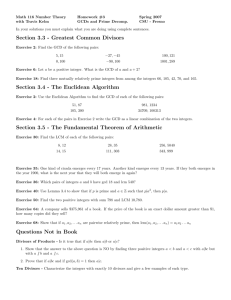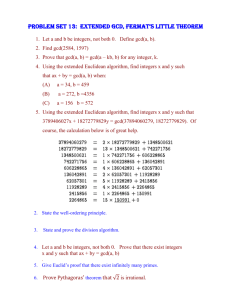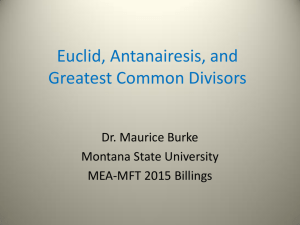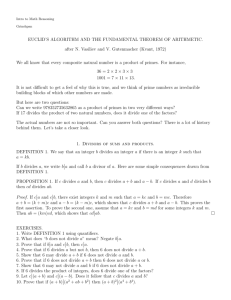GCD and LCM in Abstract Algebra: Lecture Notes
advertisement
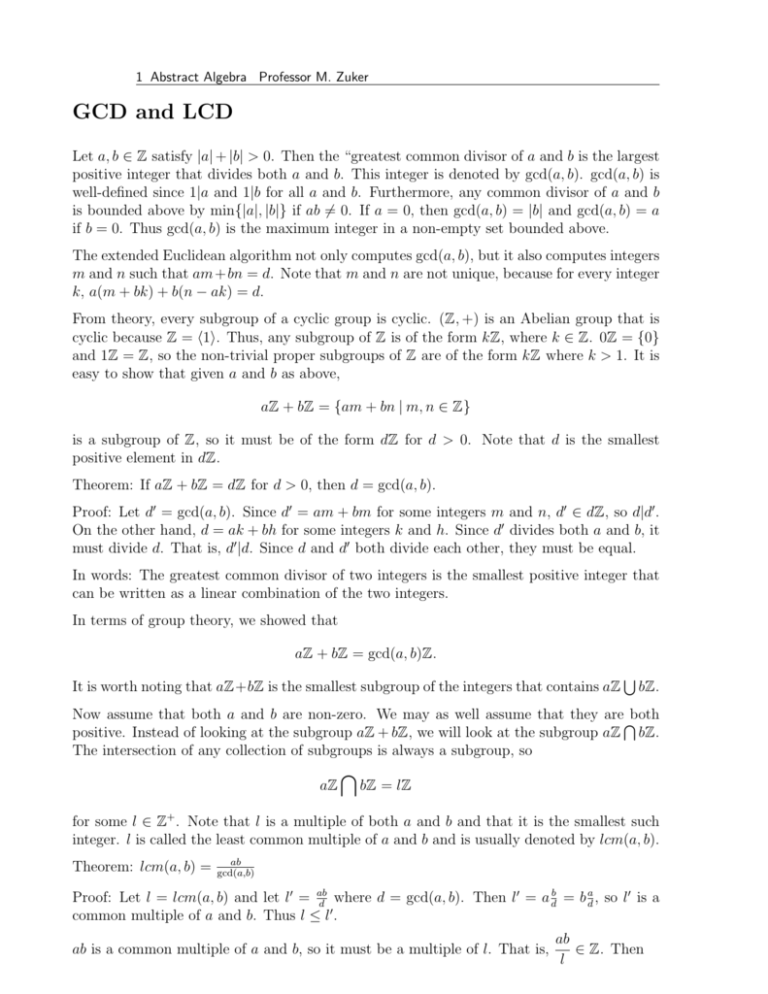
1 Abstract Algebra Professor M. Zuker
GCD and LCD
Let a, b ∈ Z satisfy |a| + |b| > 0. Then the “greatest common divisor of a and b is the largest
positive integer that divides both a and b. This integer is denoted by gcd(a, b). gcd(a, b) is
well-defined since 1|a and 1|b for all a and b. Furthermore, any common divisor of a and b
is bounded above by min{|a|, |b|} if ab 6= 0. If a = 0, then gcd(a, b) = |b| and gcd(a, b) = a
if b = 0. Thus gcd(a, b) is the maximum integer in a non-empty set bounded above.
The extended Euclidean algorithm not only computes gcd(a, b), but it also computes integers
m and n such that am+bn = d. Note that m and n are not unique, because for every integer
k, a(m + bk) + b(n − ak) = d.
From theory, every subgroup of a cyclic group is cyclic. (Z, +) is an Abelian group that is
cyclic because Z = h1i. Thus, any subgroup of Z is of the form kZ, where k ∈ Z. 0Z = {0}
and 1Z = Z, so the non-trivial proper subgroups of Z are of the form kZ where k > 1. It is
easy to show that given a and b as above,
aZ + bZ = {am + bn | m, n ∈ Z}
is a subgroup of Z, so it must be of the form dZ for d > 0. Note that d is the smallest
positive element in dZ.
Theorem: If aZ + bZ = dZ for d > 0, then d = gcd(a, b).
Proof: Let d0 = gcd(a, b). Since d0 = am + bm for some integers m and n, d0 ∈ dZ, so d|d0 .
On the other hand, d = ak + bh for some integers k and h. Since d0 divides both a and b, it
must divide d. That is, d0 |d. Since d and d0 both divide each other, they must be equal.
In words: The greatest common divisor of two integers is the smallest positive integer that
can be written as a linear combination of the two integers.
In terms of group theory, we showed that
aZ + bZ = gcd(a, b)Z.
It is worth noting that aZ+bZ is the smallest subgroup of the integers that contains aZ
S
bZ.
Now assume that both a and b are non-zero. We may as well assume that they areTboth
positive. Instead of looking at the subgroup aZ + bZ, we will look at the subgroup aZ bZ.
The intersection of any collection of subgroups is always a subgroup, so
\
aZ bZ = lZ
for some l ∈ Z+ . Note that l is a multiple of both a and b and that it is the smallest such
integer. l is called the least common multiple of a and b and is usually denoted by lcm(a, b).
Theorem: lcm(a, b) =
ab
gcd(a,b)
Proof: Let l = lcm(a, b) and let l0 = ab
where d = gcd(a, b). Then l0 = a db = b ad , so l0 is a
d
common multiple of a and b. Thus l ≤ l0 .
ab is a common multiple of a and b, so it must be a multiple of l. That is,
ab
∈ Z. Then
l
2 Abstract Algebra Professor M. Zuker
a
ab
l
=
l
∈Z
b
since b divides l. This means that abl divides a. Similarly, abl divides b, so it is a common
divisor of a and b. This means that abl ≤ d, which is equivalent to l0 ≤ l. Since l and l0 are
less than or equal to each other, they must be equal.
Thus, lcm(a, b) gcd(a, b) = ab for all positive integers a and b.



